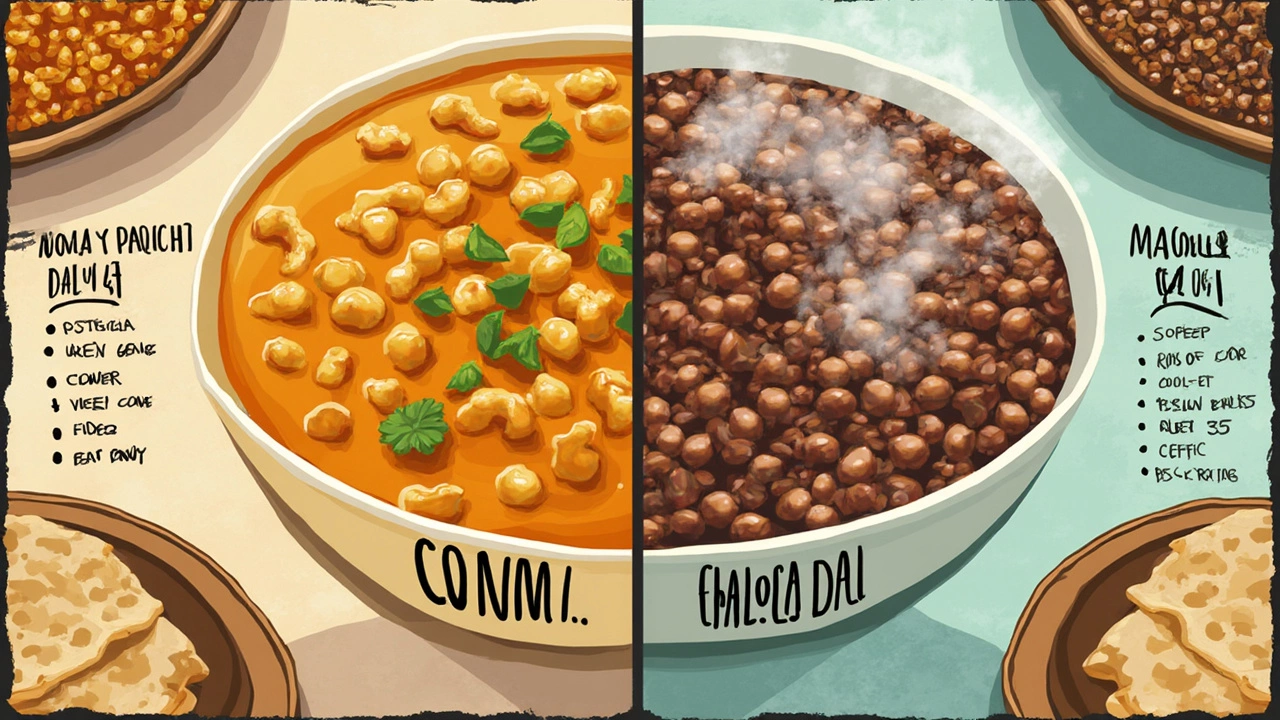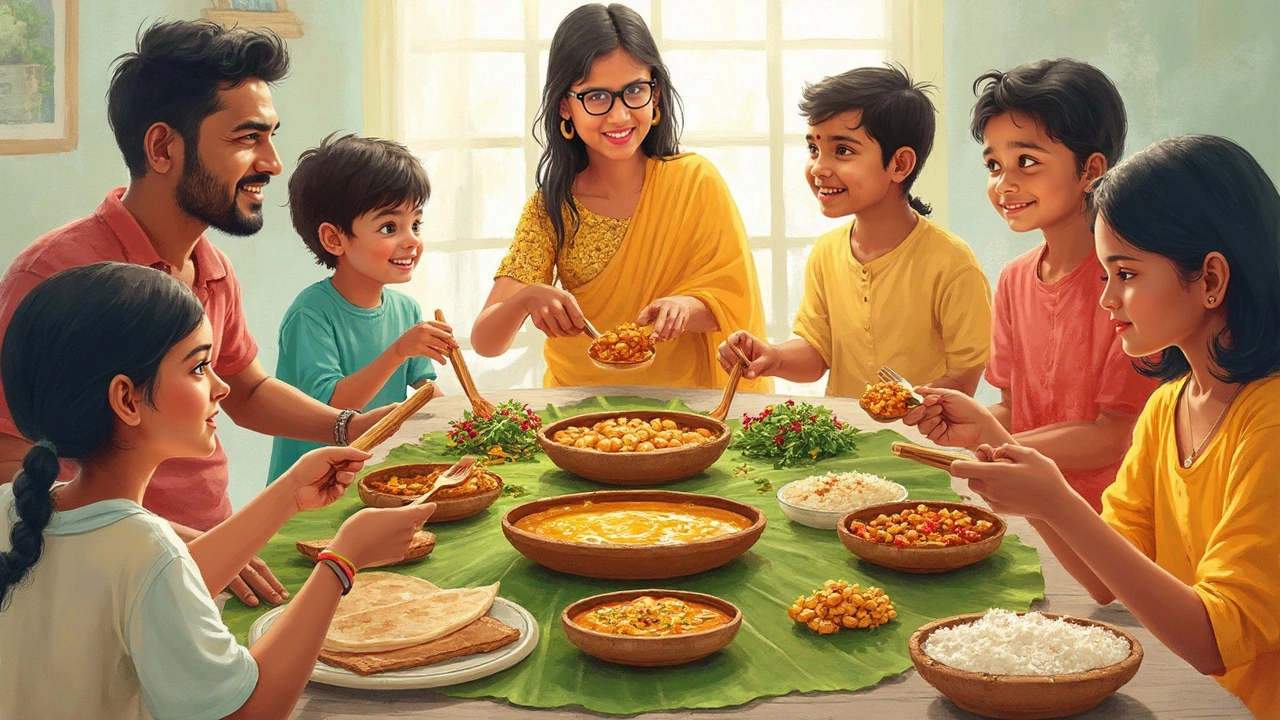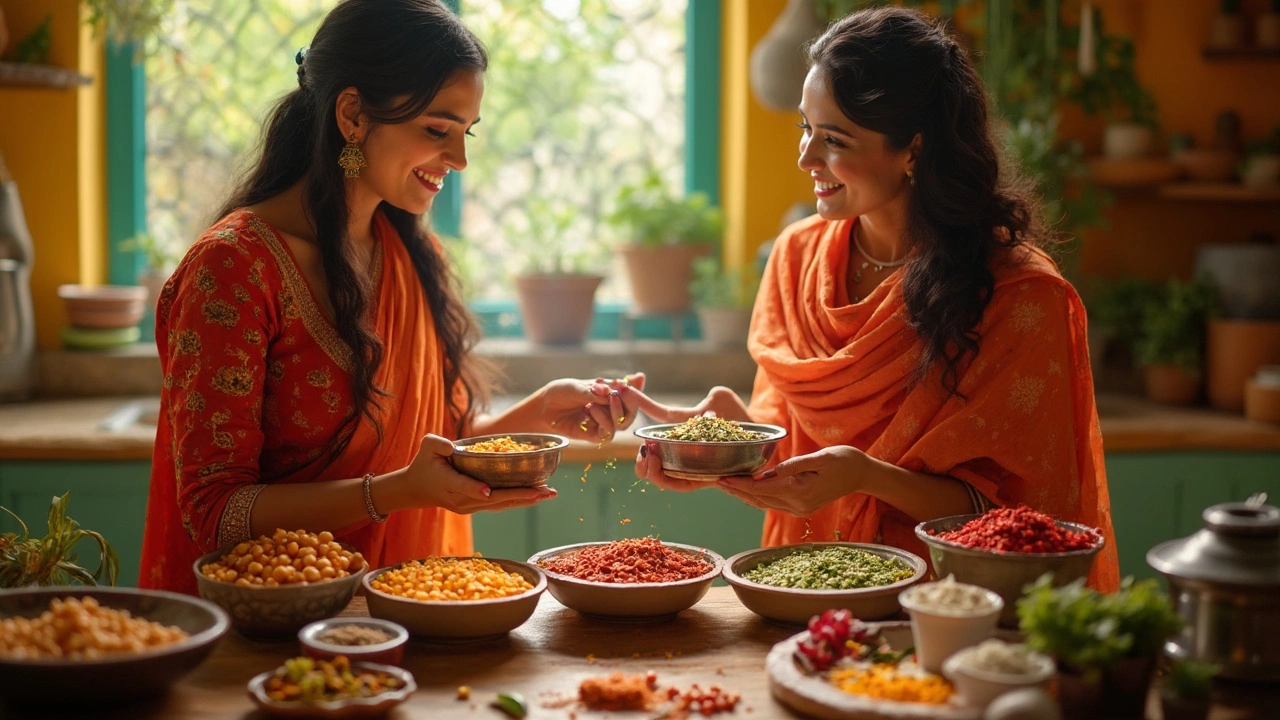You've probably stood in the kitchen, holding two packets—one of chickpeas, one of lentils—and wondered, 'Which is actually better for me?' There's no single right answer because both have strengths, but picking the one that suits your goals and your cooking style does make a difference.
If you care about protein, lentils pack slightly more per cooked cup than chickpeas. That makes them a favorite for gym-goers and vegetarians who want more muscle-friendly meals. But chickpeas bring a heavier dose of iron, which is good news if you sometimes feel low on energy, like me by Wednesday.
Both are cheap, super filling, and have their own tasty twist, so if you need to stretch groceries or want a powerhouse food, you can't really go wrong with either. By the end, you'll know exactly when to reach for which bag and how to make the most out of that simple dal recipe, even if you're cooking in a hurry or just feeling lazy.
- Nutritional Face-Off: Chickpeas vs. Lentils
- How Flavor and Texture Change Your Dal
- Cooking Times and Everyday Kitchen Tips
- Best Times to Use Each: Meal Ideas
- Which to Stock Up On: My Real-Life Advice
Nutritional Face-Off: Chickpeas vs. Lentils
Alright, let’s get to what really matters: Are chickpeas or lentils actually better for you? Everyone’s looking for affordable meals that pack a real punch, and these two are kitchen staples for good reason. Check out the nutritional breakdown per 1 cooked cup (about 165g) in this quick table:
| Chickpeas | Lentils | |
|---|---|---|
| Calories | 269 | 230 |
| Protein (g) | 14.5 | 17.9 |
| Fiber (g) | 12.5 | 15.6 |
| Iron (mg) | 4.7 | 6.6 |
| Folate (mcg) | 282 | 358 |
| Fat (g) | 4.2 | 0.8 |
At first glance, lentils come out on top for protein and fiber, so if you want to feel full longer or are chasing more muscle, they win this round. But don’t count chickpeas out — they’ve got a bit more healthy fat and their nutty taste works in tons of dishes.
For iron, both are solid, but lentils edge out just a bit more. If you struggle with low energy, both options are better than rice or potatoes. Folate, which helps keep your blood healthy (and is double important for moms-to-be), is slightly higher in lentils again. But both blow away most veggies for this nutrient.
When it comes to calories, lentils are a tad lighter, so if you’re counting, that’s another tick in their favor. But both are low-glycemic, meaning they won’t spike your blood sugar like white bread can. That’s great for steady energy all day.
- Need more protein? Go for lentils.
- Want a little more fat for flavor? Chickpeas have it.
- Looking to up your fiber? Honestly, either is solid, but lentils squeak by.
The best thing? Both are budget-friendly, work in so many recipes, and easily give you important nutrients your body actually needs. You can swap them into pretty much any dal recipe without much fuss, and your health will thank you.
How Flavor and Texture Change Your Dal
The big thing people notice first when making dal isn't the nutrition—it's the way chickpeas and lentils each change the taste and mouth feel of your meal. Chickpeas are firmer, almost meaty, and stay whole after boiling. Lentils, on the other hand, turn soft and mushy pretty fast. This affects not just the experience in your mouth, but also what spices and extra ingredients you might want to toss in.
If you like a chunky dal, where every bite gives you something to chew on, chickpeas win. Their skin gives a nice bite, and they're perfect if you're thinking about a North Indian-style chana dal, maybe simmered with garam masala and tomatoes. I use chickpeas when I want the dal to feel more like a meal and less like a soup.
Lentils melt down into your gravy, giving a creamy, thick result that soaks up spices. Try them if you're after smooth, comfort-food dal. They take on flavors easily, meaning a basic tadka (onions, cumin, garlic) explodes with taste in every spoonful. This is awesome for a quick dal fry or a hearty sambar.
Here's a simple breakdown to compare their texture and flavor in dal recipes:
| Dal Type | Texture After Cooking | Typical Flavor | Popular Uses |
|---|---|---|---|
| Chickpeas | Firm, holds shape | Nutty, earthy, mild | Chana dal, salads, hearty stews |
| Lentils | Soft, mushy, creamy | Savory, absorbs spices well | Tadka dal, sambar, soups |
Texture even changes how you serve dal. Thicker, lentil-based dals are great with plain steamed rice, while chunky chickpea dals sometimes taste better with roti or as a filling in wraps. If you care about leftovers, lentils thicken even more in the fridge (add some water when you reheat), but chickpeas hold their bite for a couple days.
So, your choice shapes more than just nutrition; it totally controls what you end up craving the next day. Trust your own taste, and don't be afraid to swap one for the other if you want to shake things up—some of my best dal bowls happened by accident when I used whatever I had!

Cooking Times and Everyday Kitchen Tips
If you just got home hungry and want to make dal fast, it's good to know that lentils are your best bet. Regular brown or red lentils cook in about 20–25 minutes on the stove, and you don’t even need to soak them. Chickpeas, on the other hand, take a lot longer. Unsoaked chickpeas can need up to 90 minutes of boiling. Even with overnight soaking, you’re still looking at 40–50 minutes to get them soft enough for a proper dal.
| Legume | Needs Soaking? | Stove Cooking Time (Soaked) | Pressure Cooker/Electric Cooker |
|---|---|---|---|
| Lentils | No | 20–25 min | 7–10 min |
| Chickpeas | Yes (for best results) | 40–50 min | 20–25 min |
Pressure cookers can be a game changer. Toss soaked chickpeas in a pressure cooker for 20–25 minutes, and they're soft, ready to absorb masala flavors. For lentils, it takes even less time—roughly 8 minutes and you’re good to go. If you forget to soak chickpeas (it happens), try the “quick soak” trick: boil them for 5 minutes, turn off the heat, and let them sit for an hour before cooking.
Some handy tips from my kitchen:
- Add a pinch of baking soda to chickpeas before boiling. It softens them faster and gives a creamier texture—especially useful for hummus or north Indian dal.
- For lentils, always rinse several times to get rid of dust and bitterness. Red lentils turn mushy quickly and are perfect when you want a smooth, thick dal.
- Batch cook and freeze either chickpeas or lentils. They reheat well and save you loads of time during the week, especially when you're running late.
- If your dal tastes bland, finish with a tempering (tadka) of cumin, garlic, and chili in hot oil or ghee right before serving—it instantly wakes up the flavor.
Honestly, lentils win the speed contest, but once you get used to soaking and freezing chickpeas, they can easily slide into your routine. My trick for a quick meal? Cook a big batch of both and mix them into different dals, salads, or even wraps all week long.
Best Times to Use Each: Meal Ideas
You might wonder when to grab chickpeas and when to stick with lentils while whipping up your favorite dal. Both get the job done, but they fit different cravings and meal vibes.
Chickpeas (chana) shine in hearty, comforting dishes. They're perfect when you want a dal that keeps you full for hours. Try these meal ideas:
- Thick chana dal for chilly nights. The creaminess and bite feel like a big hug after a long day.
- Chana-mixed sabzis or dry curries. They hold their shape and don’t turn mushy, so you can toss them into salad bowls for extra protein.
- Quick chana dal fry with chopped onion, tomato, and lots of fresh coriander—done in 15 minutes if you’ve got pre-boiled dal in the fridge.
Lentils (like masoor, moong, or toor dal) cook faster and give a lighter, earthier taste. I lean on lentils for super quick weekday meals:
- Masoor dal (red lentil) pressure-cooked with a bit of garlic, turmeric, and cumin hits the spot for lunch in under 20 minutes.
- Moong dal feels gentler on the tummy, making it my go-to when someone in the house is feeling under the weather.
- Toor dal sambar is perfect with rice for classic South Indian comfort.
Want a protein boost? Use chickpeas the day after a workout. If you need something easy to digest, go for moong dal. Lentils really earn their place for those last-minute “what’s for dinner?” moments since they cook fast. No need to soak, no need to plan ahead.
If you ask me, the dal recipe you choose can follow your mood, your health goals, and your schedule. Give both a try in your meals—they run circles around other pantry staples in terms of nutrition and flavor variety.

Which to Stock Up On: My Real-Life Advice
If you open my pantry right now, you’ll see both chickpeas and lentils tucked in airtight jars. But here’s what actually keeps me reaching for them week after week.
For day-to-day cooking, lentils win on speed. They hardly need soaking and cook fast—my go-to for last-minute dinner plans or emergency lunches when Rohan texts he’ll be home early. On rushed days, I just wash them, dump them in a pot with water and spices, and dinner’s sorted. Chickpeas, on the other hand, need an overnight soak or at least a fast pressure-cooker trick, and even then, they take longer to get soft. That makes lentils a life-saver for busy schedules.
But don’t write chickpeas off. They’re perfect for meal prep weekends. When I want to batch-cook food that’ll last a few days—think chana masala, tossed chickpeas into salad, or a thick dal—chickpeas add a nutty bite and keep their shape better in the fridge. Plus, they freeze pretty well.
Here’s a quick comparison at a glance:
| Legume | Average Soaking Time | Cook Time (Stove/Pressure Cooker) | Protein (per cooked cup) | Cost (per 500g) |
|---|---|---|---|---|
| Lentils | Not needed | 20 min / 10 min | ~18g | ₹70 |
| Chickpeas | 8 hours | 45 min / 25 min | ~15g | ₹80 |
If you live alone or tend to forget about planning meals, keep extra lentils around. For families or those who love making one-pot stews and salads, chickpeas are great. My top tip: always have at least one pack of each—they’ve saved dinner so many times, whether it’s a protein-packed dal or a hearty chole for Sunday guests.
Oh, and if you’re still confused, remember that lentils come in different types—red, yellow, green, or black. Each brings a slightly different taste and cook time, but all are super simple to adapt. If you want creamy, quick dal, go with red lentils. For something chewy and robust, chickpeas deliver every single time.
